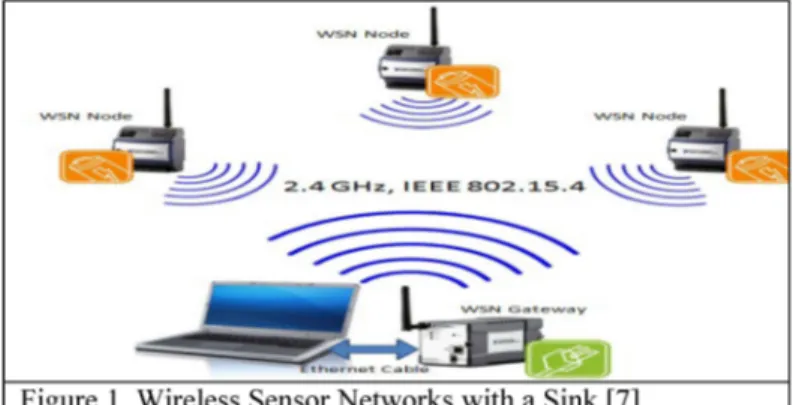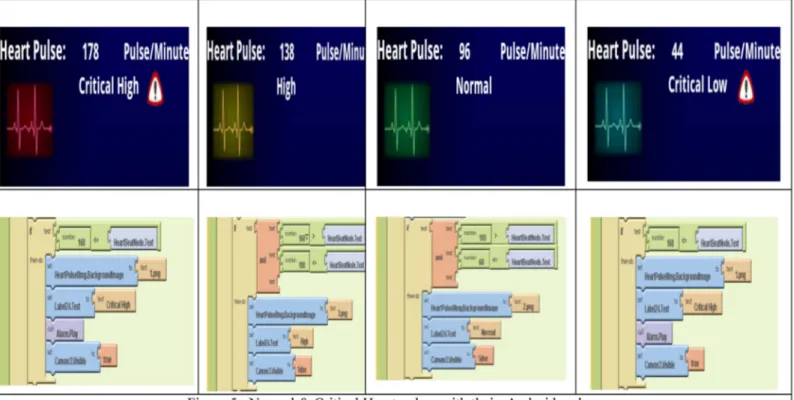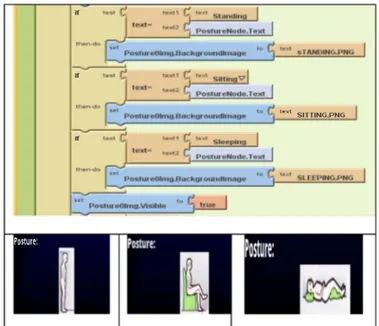A lightweight Middleware for an e-Health
WSN based System using Android Technology
Mohammed Boulmalf', Ahmed Belgana', Tayeb. Sadiki'
1: International University of Rabat Rabat, Morocco
Mohammed.boulmalf@uir.ma
Abstract-With the rapid development of Wireless Sensors Network (WSN) technology, together with its growing market due to the variety of applications in which this technology can be used, sensors are now available at very cheap prices, and relatively high quality. The medical field among other fields is one of the most promising fields in which sensors technology is undergoing great improvements. With the constant and continuing advances on the wireless sensor networks and applications, lots of medical applications that use sensors are emerging. Varying from pre-hospital, in-hospital applications to post-hospital and rehabilitation applications, sensors are used in a wide range of applications such as patient's drug administration to elderly remote supervision. With the lake of standardization, a framework that would govern the interaction between the applications and the network is a must to be capable of sensing, processing, and communicating vital health signs. In this research we proposed layered approach architecture for a lightweight portable middleware with the Android technology. Our system takes into consideration the design principles and issues related to medical applications. A prototype of the lightweight middleware for an e-Health WSN based System was designed and tested and we showed that the results are very promising.
Keywords-component; WSNs; body area networks, health monitoring, Zigbee, Android; Midlleware;
I. INTRODUCTION
A sensor network is a system that consists of thousands of very small nodes [1]. The main function of sensor nodes is to monitor, record, and notify a specific condition at various locations to other sensor nodes and end users. Eventually, this presents a wide range of applications that motivates research in sensor networks. The communication among nodes is done in a wireless fashion, and thus, the name of wireless sensor networks. One of the most promising applications is e-health using WSNs [2,3].
Recently, the healthcare industries emerged a new trend that continuously monitors medical conditions of patients, elderly, athletics, etc. everywhere and every time. This beneficial, scalable healthcare shift have been also described as a "tele medical system" solution compared to the impractical traditionally used body monitoring systems that limited the patients' activity due to its wires and thus the assessed results were severely affected. Moreover, WBASNs (Wireless body area sensor networks) alerts its personnel when abnormal,
Sara Hussein2, Tarik. Aouam3, Hamid Harroud3 2: Canadian University of Dubai, UAE
3: AI Akhawayn University in Ifrane Ifrane, Morocco
threatening changes occur and maintains a stable, optimal health condition by providing an efficient feedback [4]. It can also be used for physical rehabilitation / recovery of a crucial surgery, stroke rehab treatment, or a cardiac disorder for example [5]. Data transmission reliability is considered us an important factor to take into account while building a WBASN. Therefore, a specialized study group called "IEEE 802.15.6" group had been formed by IEEE stressing on the importance of developing a standard for BAN (Body Area Network) that will define a MAC layer and supporting many physical layers management issues [6]. As a result, a low cost, very low power and highly reliable wireless network functionalities would be promising to gain in the implementation. Building a wireless sensor network prior to all requires the constituting nodes to be developed and available. These nodes have to meet the requirements that come from the specific requirements of a given application. In other words, they might have to be small, cheap, and energy efficient, they have to be equipped with the right sensors, the necessary computation and memory resources, and they need sufficient communication facilities. Significant advantages arise from the multiple interconnected manners of nodes of a body area network where their operation together enable sensing, processing, and data communication capabilities. Each body sensor node can collect and transmit its own perceived data to a specified service node which will successively transform sensed phenomena into valuable, selective information and combine it to be delivered to a base station / server of the hospital network. This introduces another system requirement that focuses on the energy efficiency to aggregate hierarchical information. To attain an effective data transmission of the remote e-health monitoring system, a centralized mode or an ad hoc networking mode should be operating on the WBASN using a Sink (Figure 1).
II. RELATED WORKS A. Wireless Body area Senor Netorks
Nowadays, WSN has been counted as one of the most significant technologies for the 21 sl century due to the high
capabilities and low expenses that sensor networks require.
ECG&
I
Tilt sensor -...o\!"""'ii""'-":-ooCo
Sp02 &
I
Motion sensor ---I
Body
Motion
senso
...
s... --... / ..
.
..
.. ....}
...
.
Netvvork coordinator &temperaturel humidity sensor
Thus, a standard was defmed by IEEE organization called "IEEE 802.15 WPAN Task Group4" created especially for low data rate wireless personal area networks. Figure 1 shows the use of this standard among nodes and the WSN Gateway. In addition, the ZigBee standard was published and built a set of protocols of high level communication as a contribution to be used for WSNs. The acceleration of WSN market attracted a lot of countries and companies, like Crossbow Technology. WBASN is a multi-leveled telemedicine system that can be classified into three main levels. Figure 3 illustrates the architecture of a WBASN with the corresponding elements and their three levels:
Emergency
illQ
�
Caregiver Medical Serverw
�
PhysicianSensors & Radios Middleware NetVW'ork
SoftV\lare Operator Provider Internet
Server Applicat:ion
Soft\lvare Soft>.Nare
I
Mobile Hub GPRS l..-n-t NetV'J'ork--
�
AppI-L.-______ ... Medical Center ... �----.,,/,---/
... �---.,,/Level 1 Level 2 LevelS
Figure 2: Multi-leveled WBASN with corresponding elements Level i: includes a number of wireless medical sensor nodes
that are integrated into a WBASN. Each sensor node can sense, sample, and process one or more physiological signals.
Level 2: covers the personal server (PS) application running on a Personal Digital Assistant (PDA) or a cell phone. The PS is in charge for a number of tasks, providing a transparent interface to the wireless medical sensors, to the user, and to
the medical server. The interface to the WBASN includes the network configuration and management that encompasses the following tasks:
• sensor node registration • initialization
• customization
• setup of a secure communication
If a communication channel to the medical server is obtained, the PS establishes a secure link to the medical server and sends reports that can be appended into the user's medical history/record.
Level 3: involves a medical server or number of servers accessed via the Internet. It can issue recommendations, and even issue alerts if reports seem to indicate an abnormal condition.
For instance, users who has a predisposition for heart disorders may continue their normal daily activities, but they are equipped with several non-invasive medical sensors applied as tiny patches on their skin. The Personal Server application can discriminate their posture state using the data from the motion sensors, and can also detect an abnormal event by examining/analyzing the data from the ECG sensor. If an abnormal state is noticed through the users' activity, heart rate, and personalized, they will receive a warning. In addition, a detailed incident report can be sent to the medical server at the users' hospital or doctor's office.
In this research we focused our work on level 2 by developing a light middleware using the Android technology. We simulated all body sensors (level 1) with Android codes. The critical values will be sent to the middleware for processing.
III. LIGHTWEIGHT MIDDLEW ARE FOR PERSONAL HEALTH WBASN
The main motivation in this section is to develop a suitable middleware or appropriate programming environment to express a health based application in WSN. The middleware is usually used as an approach to satisfy the adaptation functions and fill the critical gap that exists between applications and network protocols to attain the requirements of WSN and its diverse application. However, for a health monitoring system, more accurate essentials should be approached and taken into regard due to this application environment and limited resources. Moreover, people now are accustomed to using mobile phones in everyday life and as a consequence we are reaching a situation where an increasing number of applications and services are available for mobile users. Mobile phones are utilized in accessing services and information content in the network due to recent advances in mobile software. Mobile phones are also used as organizers, data repositories, and containers for users' applications and not restricted for simple communication purposes. Apparently, none of the existing systems and architectures is designed to be used in such resource-constrained devices as mobile phones are. Lightweight middleware architecture for
wireless body area network should be implemented and designed to best suit the development of ubiquitous mobile integrated application to screen health conditions. It generally contributes to accelerate the development of wireless hardware applications by giving highly reusing codes. Its primary functions are data acquisition, dynamic plug and play capabilities, on the sensor reconfiguration, resource management and security feature to protect critical sensor data from damages and unauthorized parties. This Body Area Sensor Network (BASN) middleware continuously captures and receives raw, quantitative data from a variety of sensors for longer periods, processes and transmits to application (data acquisition). These specifications enable medicine beyond the borders of hospitals because of its human centricity characteristic. To avoid data collision in the multiple sensor devices platform, WBAN MAC scheme has been used that relies on star topology and a master slave. The determined mode of WBAN MAC communication is used for response message of resource control commands [9-13].
IV. ANDROID P ALNFORM FEATURES
Android is a software stack for mobile devices that includes an operating system, middleware and key applications. The Android SDK provides the tools and APIs necessary to begin developing applications on the Android platform using the Java programming language. There are several platforms for Android software development. The easiest one is App Inventor [8].
App Inventor is open-source software that can be used to develop the middleware of the home health-care system. Its tools contain mainly blocks that can be connects to fulfill a specific job or behavior. These blocks can perform many of the Android phone actions, as well as blocks for doing "programming-like" stuff, blocks to store information, blocks for repeating actions, and blocks to perform actions under certain conditions as done for the middleware. App Inventor software involves many options that aide in performing the different tasks needed to meet the expected architecture and performance of middleware. It has two views for the user: a Designer (Fig. 3) and a Blocks Editor (Fig 4). The Designer defmes all sorts of components and the Blocks Editor defmes the behavior of these components. In other words, the Blocks Editor uses the Open Blocks Java library for creating visual blocks programming languages, while the designer allows the capability to design GUIs for the application.
--
.,
Figure 3 Designer view of the middleware
.
�
" ..
- '- -- -- - . -... I � -_. �" ....-
�
f---·-'i:::.!J�
-_.--_.. �: __ � .• ""_ .. _ 0': _. __ .- �� ----_. "- --':--l--c'-
- .... - .. ---��Figure 4 Block Editor View
A. Description of Lightweight e-Health Middleware Blocks In the Blocks Editor, Built-In and My blocks are the two main tabs available to assist in programming the middleware or application. The 'Built-In' tab includes many sub tabs of definition, Text, Lists, Math, Logic, Control and Colors as shown in (Fig 4). 'My Blocks' tab adds all the blocks used and named specifically by the user. In the Designer view, it offers
many options through its palette tabs, components tabs and properties tabs (Fig 3).
In order to accomplish the implementation stage of this project, we used App Inventor software with many options that aided in performing the different tasks needed to meet the expected architecture and perfonnance of our Android middleware. This Android Middleware communicates with many body sensors like heart pulse, temperature, blood pressure, and posture sensors:
The heart pulse sensor 'HeartBeatNode' provides information about the number of heart pulse by minutes in a normal
condition the heart pulse range is 60 to 100, if it's not the case critical message appear. For the HeartBeatNode, the block chooses a random integer from the random item that includes different ranges for the heart pulse readings. We increased the probability of the normal heart pulse case which is assigned to be between 70 and 110. Figure 5 illustrate the normal and critical heart pulses and their Android codes.
The temperature Sensor 'TempNode': for this sensor the block chooses a random integer from the random item that includes different ranges for the temperature readings. We increased the probability of the normal temperature case which is assigned to
be between 37 and 38. It is also taken into account to display float results (Figure 6)
.. • ... rm . .. pHl"-lM
.. r
l
.
�
.. .. .. .. -.. ..�..
��
".... �
·
"
I
_"-• ... 11 ""'"u I ...IlalnC�"·d
.. ��
.
r
-
�
''''
-�-... 11: -.. � ' ... � .. �L ...·,J
.. �� r
-�" ,-,-..,... .... " ... '*II ' ...�
�
.
ri
. ,J_
.. �'P-:-:l r
-c." ,-�-rl
,--. "")1 ' ... InrI ...c..�
.
,
I
.
.
�� 'I'
-c.
.. ',_".r
l'
,-.... ....
.
.
.. ...
1-
�
-
,
1
���
.
I"
--c,,,
__�.
""'"- • -.
:
.
.."'.-
'-�"�"
I
rFigure 6 Android codes for Temperature Sensor
The Pressure Node picks a random reading of the systolic/diastolic blood pressure and the probability of the normal case (120/80) has been increased (Figure 7)
The PostureNode is assigned to display 3 different postures of the user including standing, sitting and sleeping. Figure 8 shows all the postures and their Android codes.
,.� c .... ",_ •••••
""'- ... 3 Ill. 6 .... , ... ..
•••• ,':06'0',
,,-,- c; .... " .. , �
Figure 7 Android codes for Pressure Sensor
Posture
I
if if if text SITTING.PNGFigure 8: Posture Sensors and their Android Codes
V. CONCLUSIONS AND FUTURE WORK
As a result of this research, we proposed a layered approach architecture for a lightweight portable middleware taking into consideration the design principles and issues related to medical applications, we elaborated on the design concerns related to this middleware and finally we developed and tested a prototype of the lightweight middleware for an e Health WSN based System using Android technology.
REFERENCES
[I] K. Shoraby, D. Minoli, and T. Znati, "Wireless Sensor Networks: Technology, Protocols, and Applications ," Wiley Interscience, 2007 [2] Victor Shnayder, Bor-rong Chen, Konrad Lorincz, Thaddeus R. F.
Fulford-Jones, and Matt Welsh.; "Sensor Networks for Medical Care", Harvard University Technical Report TR-OS-05, April 2005
http://www.eecs.harvard.edu/-mdw/papers/codeblue-techrept05.pdf [3] Eugene Shih, Vladimir Bychkovsky, Dorothy Curtis, and John Guttag,
"Demo Abstract: Continuous Medical Monitoring Using Wireless Microsensors", SenSys'04, November 3-5, 2004, Baltimore, Maryland http://ddmg.csail.mit.edu/publications/medical-monitoring-abstract sensys2004.pdf
[4] Chris A. Otto, Emil Jovanov, and Aleksandar Milenkovic; "A WBAN based System for Health Monitoring at Home", Journal of Mobile Multimedia, Jan 2006
http://ieeexplore.ieee.orglxpls/abs_ all.jsp?arnumber=420 1256
[5] A wireless body area network of intelligent motion sensors for computer assisted physical rehabilitation
http://www.pubmedcentral.nih.gov/articlerender.fcgi?artid=552302 [6] IEEE S02.15 Working Group for WPANs. Retrieved from:
http://ieeeS02.orglI5/pub/Subscribe.html(2012)
[7] Pagano P. (June 25, 200S). Wireless Senosr Networks. Retrieved from www.artist-embedded.orgidocs!Events/200S!RT .. .IsS-wsn-erika.pdf [S] www.android.com
[9] Emerging Technologies. Middleware Technology. Rogers State
University. Retrieved from
www.faculty.rsu.edu/-clayton/ns/middleware2.doc -(20 II)
[10] Salminen T. (2005). Lightweight middleware architecture for mobile phones. University of Oulu, Department of Electrical and Information
Engineering. Retrieved from
www.mediateam.oulu.fi/publications/pdfl7ll.pdf
[II] Mehdia A. K. (Spring 2009). FlexRFlD. A Flexible Middleware for RFID Applications Development. Master thesis Report Paper. Al Akhawayn University.
[12] Why Go Wireless: Weighing the Benefits and Challenges of Wireless Remote Monitoring. (August 8, 2008). National Instruments. Retrieved from http://zone.ni.com/devzone/cdaltut/p/id/7141
[13] Khan J., Yuce M., and Karami F. Performance Evaluation of a Wireless Body Area Sensor Network for Remote Patient Monitoring. Retrieved from
www.eng.newcastle.edu.au/-mryI22/EMBC08_OPNET_ Zigbee Jinal. pdf -(20ll)


